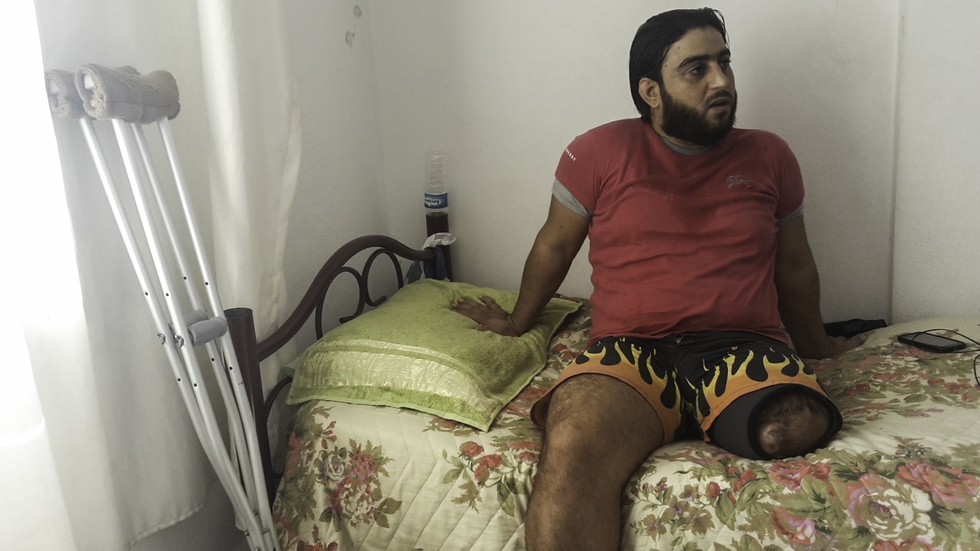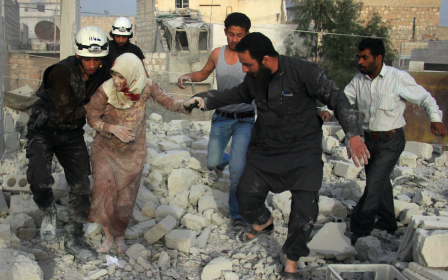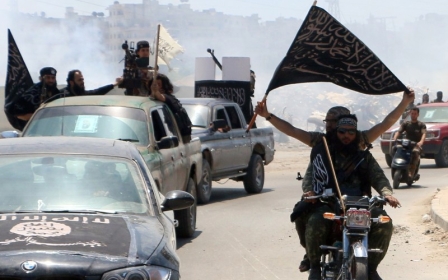Underground clinics in Turkey treating Syria's wounded to fight on

REYHANLI, Turkey - A group of men with heavy beards and half-healed scars hangs out near a garage nestled in the backstreets of this town in Hatay Province in southern Turkey.
They eye newcomers with suspicion as they whisper among themselves and recline against the spattered grey shell of a neighbouring apartment block. These men are not mechanics. Instead of guarding a garage that patches up cars, they stand watch outside an unlicensed medical centre where fighters from Syria are sent for treatment before being shipped back to the front.
Reyhanli is a stone’s throw from the Syrian border and a place where rebel groups have been sending their wounded to clinics like this one.
The clinic’s director Fahet says he opened it two years ago. He does not have a permit from the Turkish government, but said the authorities have repeatedly turned a blind eye.
“The Turkish authorities are aware of the clinic’s existence, but they never create trouble,” he told Middle East Eye.
The kinds of cases treated here tend to be extreme. The halls reek of disinfectant as injured Syrian men limp about the clinic. Some wear plaster casts, others are on crutches and some are recovering from amputations.
At any given time, the clinic is helping about 30 “hot” cases, people who have been wounded by mortars, shrapnel and bullets and those who have been paralysed by their injuries.
Despite the shady exterior, the facilities are superior to what one might expect. There are gleaming white walls, plasma TVs and comfortable beds.
There are no adult women here, and the clinic mainly caters to men aged 20 to 40 who have come from the Syrian towns of Idlib, Hama and Aleppo.
This particular clinic treats fighters affiliated to Ahrar al-Sham, a Syrian group that has fought in alliance with al-Qaeda, but almost every major opposition militia is said to have its own. The groups say it is a moral and religious duty to look after their wounded fighters, and when necessary, their families as well.
Jabal Ezzawie, a fighter from Idlib, brought his three-year-old daughter here after she was hurt in an air strike and the pair is now staying at the centre while she recuperates.
“Some observers from our headquarters told me Russian airplanes were going to bomb my part of town,” Ezzawie said.
He ran home immediately, but arrived just in time to see it collapse with his daughter inside.
“She was wounded, so I jumped in a car and rushed to the border crossing at Bab el Hawa [and to the clinic].”
Doctors performed emergency surgery on her hand and arm; Ezzawie says she is recovering quickly.
Pushing his crutches aside, Gazwan Darwisa, a man in his thirties with a full beard, said he was less lucky. He lost a leg to a Russian air strike and has been an in-patient at the facility for seven months.
“Take all the pictures you want. I don’t care, I’m already on the regime’s blacklist,” he said, laughing.
Recovery has been a long, difficult road. Darwisa was first operated on in a hospital in the Turkish town of Antakya, but was moved here to begin his rehabilitation and is now waiting for a prosthetic limb.
The pattern of shipping people from the battlefield to a network of semi-legal medical institutions in Turkey has become an all-too-familiar one.
“All the serious injuries go straight from the border posts of Bab el Hawa and Bab el Salama to the nearest Turkish hospital,” Dr Hazem, the only doctor servicing the clinic, told MEE.
He is in his early 20s and has only four years of medical school under his belt, but when the war forced him out of the classroom, he began working in makeshift hospitals that sprang up to treat the throngs of wounded fighters.
“After operating, patients are sent to one of 21 informal clinics in Hatay province or hosted in private houses,” Hazem said.
While Turkey provides free medical care to registered Syrian refugees, it cannot cope with the stress of tens of thousands of wounded, which creates a need that the illicit medical centres are filling.
Turkey’s Blue Hospital
Since 2012, Reyhanli’s so-called “Blue Hospital” has been at the heart of this conveyor-belt system. It is the largest private hospital in the region and has an advanced rehabilitation centre with a cardio zone, physiotherapy machines and beds for as many as 60 patients who are cared for free of charge.
Staff here have saved countless lives, but the project (much like the small garage clinic) is not legal. Management says it exploits registration loopholes to stay under the radar, but this unofficial arrangement has caused some to discern political motives.
The Blue Hospital and the small garage clinic’s staff are quiet about their funding, although both say they have received aid from a controversial Turkish humanitarian organisation, Insani Yardim Vakfi (IHH).
“IHH works closely with Ahrar al-Sham, providing support in the territories that have come under the group’s control in northern Syria. It builds field hospitals, water tanks and distributes food,” said Rami Jarrah, a Syrian journalist from the ANA Press Syrian news site.
According to Jarrah, this has helped strengthen Ahrar al-Sham, which increases its level of control by providing basic services for populations in its areas.
Dr Omar Aswad from the Syrian Expatriate Medical Association said IHH supports most of the clinics in Reyhanli and Kilis and works with NGOs.
“All the NGOs working remotely are dependent on IHH’s licence approval as well as IHH’s convoys to transport humanitarian aid inside Syria,” he said.
The group has also been linked to the smuggling of arms under the guise of humanitarian aid, although it denies these claims.
Many of those who seek treatment say they plan to return to the front.
“When I’m 100 percent recovered I’ll be ready to go back and fight again,” Somar, a 23-year-old from Hama, told MEE, stressing that the level of care has been good and professional.
But there is no guarantee that if he is wounded again, he will be able to count on one of the illicit clinics to successfully patch him up. Not all illicit, unregulated clinics are equal.
In a field near the Turkish town of Kilis, a few kilometres from Bab el Salama, a yellow barracks converted into a clinic squats along a dusty road. It too is funded by IHH and is filled with men suffering gruesome war injuries, but conditions are far worse.
The patients do not wear gowns but don sweaters and hats embellished with the Saudi Arabian flag. The men are squeezed six or seven per room, the floor is dirty and the stench of death lingers in the air. Some belong to Ahrar al-Sham while others claim allegiance to the Free Syrian Army (FSA). Almost all were sent to the clinic from Turkish hospitals in Kilis or Gaziantep.
Last April, a government sniper shot Shadi Shekri, 37, in the chest while he was fighting in Aleppo with the 16th Division of Salaheddine Brigades under the FSA umbrella.
“I crawled on the ground so I would not be shot once again. I rolled into a ditch, hoping one of my teammates would see me and come to my rescue before I lost consciousness,” he said.
By the time he woke up, he was in a Gaziantep medical ward. He did not have identification or money, but it was not a problem.
“In Turkish hospitals, there is always a facilitator for the fighters, each one in charge of a different brigade. His job is to provide you with documents and a kimlik (Turkish residence permit that allows you to be treated),” Shekri said.
Facilitators also provide advice and support to the wounded, and help find clinics that will heal them enough to send them back to the front.
- Additional reporting by Eleonora Vio
Middle East Eye propose une couverture et une analyse indépendantes et incomparables du Moyen-Orient, de l’Afrique du Nord et d’autres régions du monde. Pour en savoir plus sur la reprise de ce contenu et les frais qui s’appliquent, veuillez remplir ce formulaire [en anglais]. Pour en savoir plus sur MEE, cliquez ici [en anglais].





